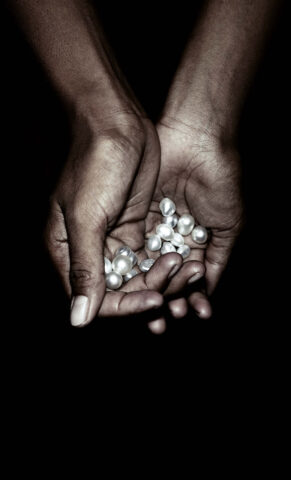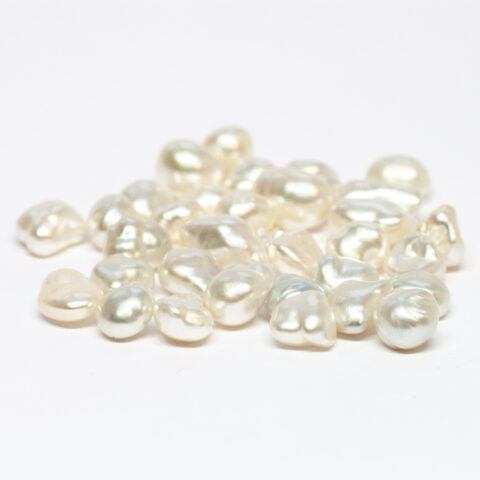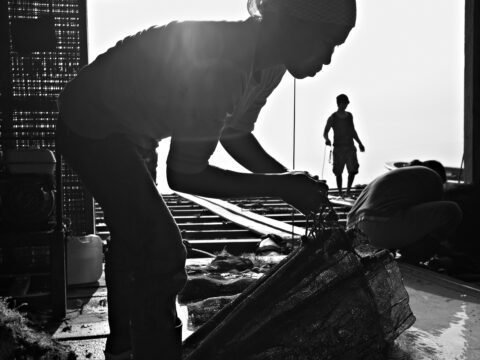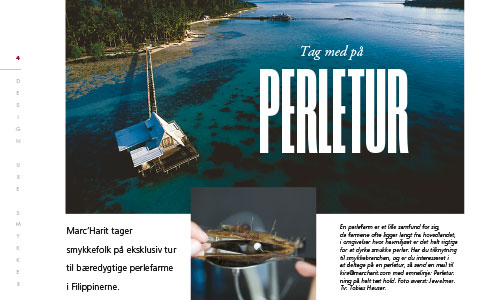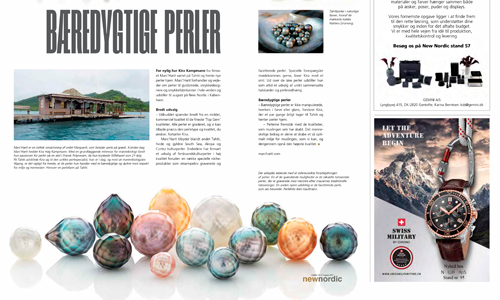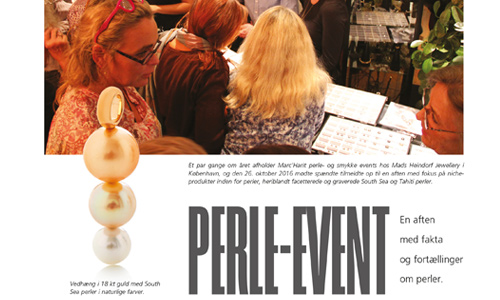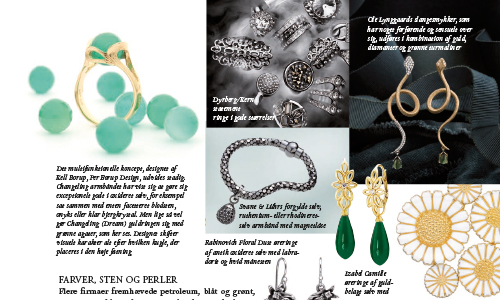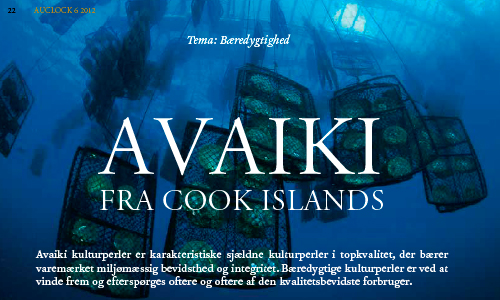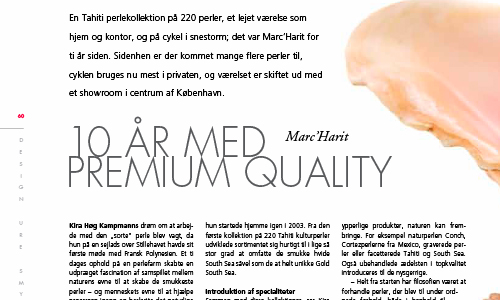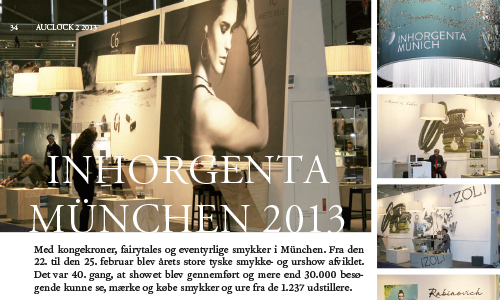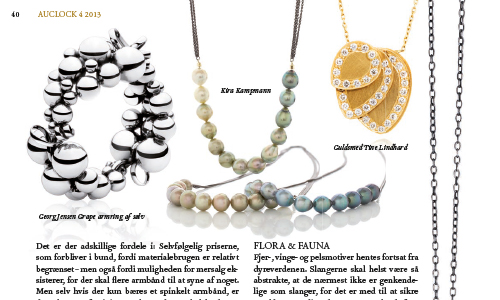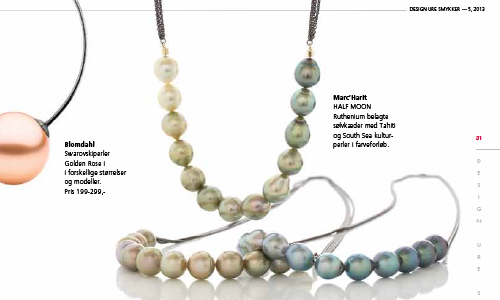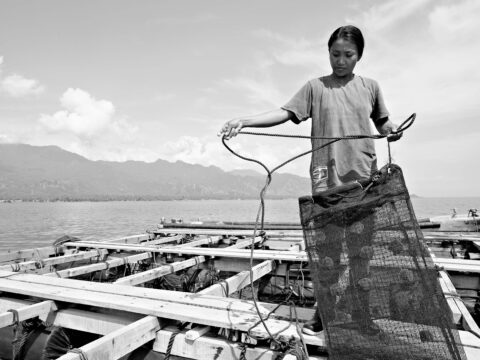
A woman is working on a raft, on which the holding nets are attached. The holding nets are where the oysters are kept during their life. Here they can be cared for until its time for the pearls to be harvested. Photo credit: Atlas Pearls
This article will focus on one of our main suppliers of White South Sea Pearls, Atlas Pearls.
After the article we will share some news from our partners in French Polynesia.
The background
We have a close relationship with our suppliers and openness and transparency through the value chain is very essential to us. We want to clarify the pearls’ journey from ocean to your hands, all the way until it ends as a part of a piece of jewellery.
As one of our valued white South Sea pearl suppliers, Atlas Pearls started their venture in Kupang (Indonesia) in 1993 and have since moved to Raja Ampat in West Papua, where the pristine waters are rich enough to provide excellent conditions for the South Sea Pearl oysters. They have since expanded their operations, and they have farms spread throughout the Indonesian South Sea. This helps to mitigate the risks of natural disasters.
We have over the years established a close partnership with Atlas Pearls and we have visited the pearl farms in person, in order to be able to verify the environmental initiatives. Atlas Pearls takes an environmentally friendly approach to business through the very nature of pearling itself where a pristine, healthy eco-system is of central importance to the oyster’s survival.
An peak inside the pearl farm
The harvest.
This is the moment of truth, as there is no way of knowing the quality of the pearls before they are removed from the oyster.
The video below shows some of the last activities that the pearl oysters undergo. We want to give you this glimpse info the farming process, due to the amount of craftmanship, which Atlas Pearls put into it. A high level of delicacy is needed, as the oysters need to be handled gently in order not to stress or harm them.
The video is from a farm which resides in beautiful Alyui Bay in Indonesia where the oysters reside in the rich, nutritious ocean. A glimpse of some of the specific activities revolving around a pearl harvest.
At Atlas Pearls, after gathering the live, ready to harvest oysters, out in the bay, they are carefully loaded onto wagons and moved to a workspace where they can be freed from their holding nets, where they live their life in the ocean. The skilled workers carefully remove them and make sure they are not harmed in the process. Afterwards, the individual oysters are washed and inspected. At this step the oyster is slightly opened, to allow the technician to delicately remove the pearl, which then can be cleaned, graded and sorted.
Even though the pearls are cultured, only 50-60% of the pearls are of a high enough quality, to be considered jewellery grade. These steps shown in the video, is just a few of many steps which the pearl oyster experiences from hatchery to harvest.
After the harvest the oyster will usually get a new nucleus inserted, and thus a new pearl can be produced. Those oysters which do not produce pearls of high enough quality, gets utilised otherwise. Here the meat gets used for food, the mother of pearl can be used for all kinds of decoration products, watches etc., and the remaining parts of the shell can be ground and used as fertiliser in either farmland or in the ocean. This creates a sustainable production where every part is used. Atlas Pearls are also focussed on enhancing the lives of the surrounding communities with employment, training education and community support. We will tell you more about these adventures in another pearl letter.
Present picture
The farm as we speak: At the Indonesian pearl farm, grafting and harvesting continue, although at a slightly slower pace. But pearls keep coming out of the pristine waters and we are thankful to have received no less than three new shipments of these fantastic sustainable South Sea pearls.
Our mission
The immediate as well as the long-term benefits of sustainable pearl farming can make a real difference for our oceans, local communities, and people dependent on the oceanic and coastal resources.
Marc’Harit’s mission is to enlighten the world of the great advantages of high-quality pearls farmed through sustainable pearl farming, this way influencing buyers, creators, and wearers to choose their pearls consciously. Our vision is that all pearl farming one day will be sustainable where possible, this way benefiting nature as well as humans.
This is a long journey, and we take one step at a time, and are convinced that together we can make a real and positive difference.
Pearl farming is one of the few economic activities that enrich the environment instead of diminishing it. As the only living gem, the pearl relies on pristine environmental conditions and pearl farmers have to make certain that the waters and islands surrounding the oysters’ habitat have to be clean and thriving with life. They are at the forefront of ocean conservation, of lobbying against cyanide and dynamite fishing, and are the first to witness the effects of climate change. In return for this care and attention, the presence of oysters filter the water and provide protection for marine life, which encourages biodiversity to flourish.
Tahiti – another pearl world
News from outside our borders directly from the pearl farms.
Even though we haven’t been able to travel and visit our pearl suppliers, we’re in constant dialogue with them. As it is, even though the societies of the world are somewhat still in lockdown, nature is moving forward.
Kira has been on a virtual tour to Tahiti, and have had a pleasant dialogue with our partners, suppliers and pearl farmers in French Polynesia. They tell us that due to COVID-19, oysters in the area have not been regrafted since February 2020, and many farms are without grafters. This means we will face a decline in larger pearls at some point soon. The same is true for fancy colours and the very lustrous qualities.
The good news is that the lagoons get a healthy break and get time to regenerate. We hope that this will mean pearls with more vibrant colours, better lustre and in general better quality – even if the results may only show in 3-5 years from now. We have something to look forward to.
In the meantime, we do everything we can, here at Marc’Harit, to acquire new pearls of the same, high quality, as you are used to find in our pearl trays. Never stop being a Finder of Pearls.
Thank you
We thank you for taking the time to read this March newsletter, we hope you have enjoyed it and perhaps learned a thing or two about how a pearlharvest can take place, at least at one particular farm.
We will continue to tell the stories of pearls, as there is a lot of information, just waiting to be shared.
Best regards from the Pearl Lab
Kira, Rikke & Peter

